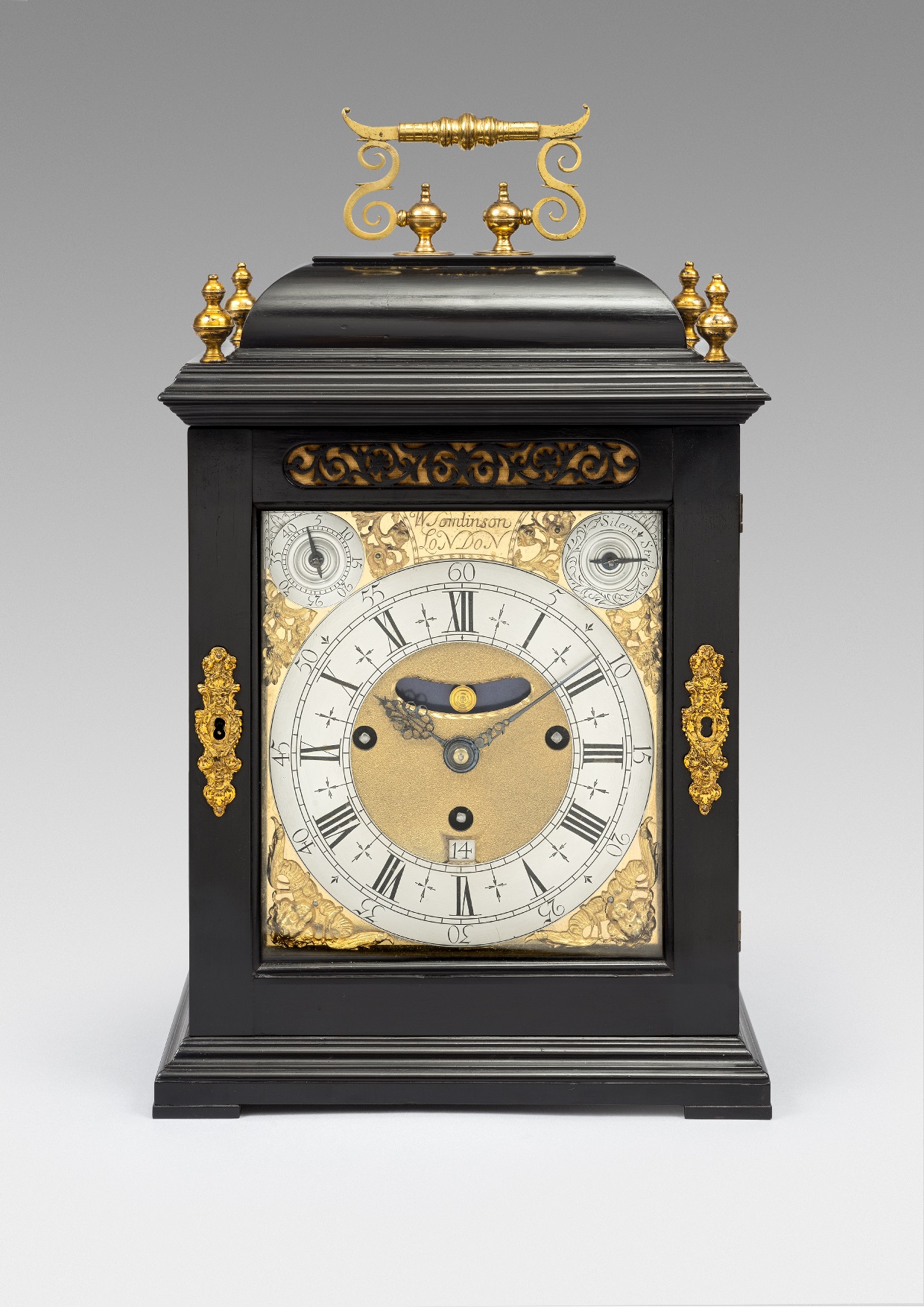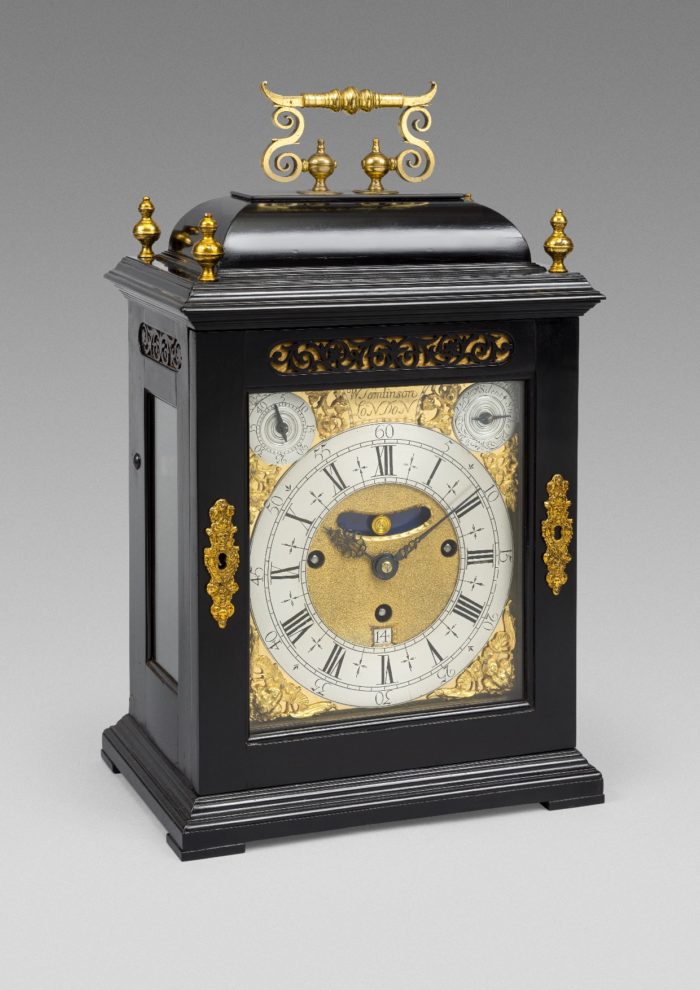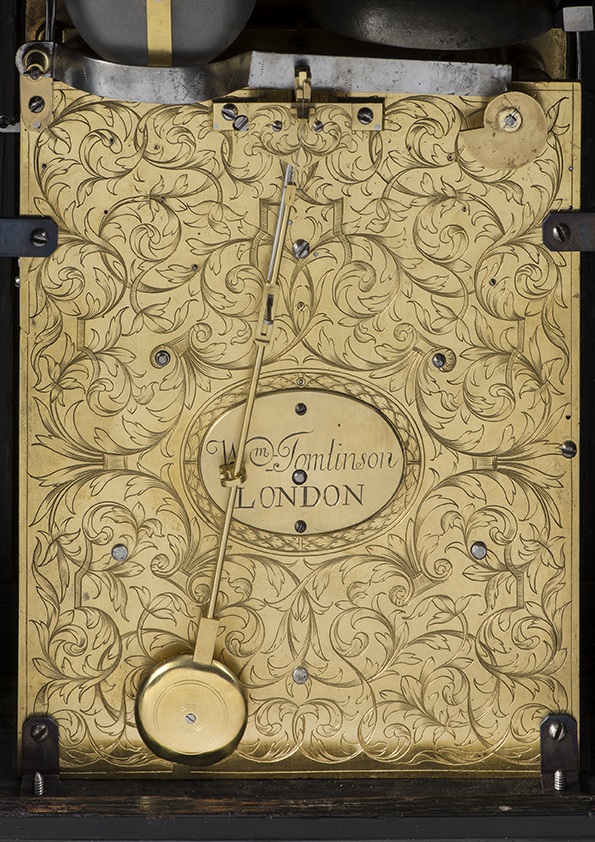A RARE WILLIAM III GRAND-SONNERIE CLOCK: FROM THE WORKSHOP OF DANIEL QUARE, LONDON, DATED CIRCA 1695
September 15th 2015
It is very exciting for Raffety to be able to offer a grand-sonnerie striking bracket clock made by the illustrious maker Daniel Quare of London, that has been acquired by us from a private source. This fine quality table clock was made in Daniel Quare’s London workshop, and shows both in the case and movement design, together with the style of both the under-dial work and the wheelwork between the plates, to be entirely his work.

Ebony Grand-Sonnerie Table Clock, from Daniel Quare’s workshop, circa 1695. Raffety Ltd
Daniel Quare was of course one of the great names from the golden age of English clockmaking, and he was a justly worthy contemporary of Thomas Tompion, George Graham and Daniel Delander. He was born in circa 1647 and became a Brother of the Clockmakers’ Company in 1671. He went on to serve as Master in 1708. While he was highly successful, having both King William III and many of the aristocracy among his clientele, it is well documented that he did also make clocks for sale to other clockmakers, and this clock would appear to be an example of this practice.
In the late 17th and early 18th century it was not unusual for eminent clockmakers, including Thomas Tompion, to occasionally sell on clocks to other makers, who would in turn retail them under their own name. Indeed, if you had superfluous stock it made good financial sense to do this.
This clock, with rare and complicated grand-sonnerie strike, is fully signed on the front and backplate by William Tomlinson, and dates to circa 1695. Tomlinson was from Preston in Lancashire, but was an established clockmaker in London and worked at the Dial & Three Crowns, Birchin Lane, near the Royal Exchange. He became Master of the Clockmakers’ in 1733 and died aged 77 in 1750 – he is buried at Bunhill Fields.
Angle view of the clock. Raffety Ltd.
The clock has a finely moulded and ebony veneered case with gilt escutcheons, together with four baluster finials to the shallow caddy-top. This is surmounted by the double “S” scroll carrying handle, a feature closely associated with Quare’s casemaking.
The gilt rectangular dial is signed ‘William Tomlinson, London’, within a cartouche and flanked by cast, scrolled mounts and two subsidiary dials for regulation and strike/silent of the grand-sonnerie work. There is a classically proportioned chapter ring with pierced blued-steel hands, again very much in Quare’s hand.
The substantial 3-train grand-sonnerie movement is clearly and entirely Quare’s work. It fills the case interior and strikes each quarter-hour and hour, at each quarter, and at will. The backplate too is elaborately engraved with scrollwork, again consistent with Quare’s engraving style known on other clocks of his from this period.
Like Quare, Tomlinson was a Quaker, and might well have first met Quare at the Quaker meeting house in Gracechurch Street in the City. It is therefore well within the realms of possibility that the two were not only acquainted but were happy to help each other out in business when there were opportunities to do so.
Backplate of the clock, signed William Tomlinson. Raffety Ltd
There is however another unexpected and fascinating layer to this clock – the backplate has the name ‘Phill. Constantin’ underneath the oval plate bearing Tomlinson’s name, and clearly Philip Constantin was intended to be the original retailer for this clock.
Philip Constantin, was a member of London’s Hugeunot community, situated in Spitalfields. Philip seems to have moved from France to London to join his brother Jean, who was already working in London as a clockmaker, no later than early 1696.
It is possible, as the date of the clock coincides with Philip’s arrival in London, that the purchase and signing of this clock was intended to mark his entrée into the London clock trade, but it would appear the purchase fell through for unknown reasons. Quare then seems to have sold it on to Tomlinson at a later date.
This clock is a magnificent and rare example of the clockmaker’s art at the end of the 17th century, incorporating rare and original grand-sonnerie strike. This clock also provides a further insight into Quare’s business practices and willingness to supply top-quality clocks to fellow clockmakers of his day.
Nigel Raffety & Tara Draper-Stumm
Further Reading:
See P.G. Dawson, C.B. Drover & D.W. Parks (et al). Early English Clocks (Antique Collectors’ Club, 1982), p.377 for an almost identical movement and p.373 for a Quare backplate with almost identical engraving to this clock.
See Richard Garnier and Jonathan Carter, The Golden Age of English Horology (Winchester, 2015), pp.282-3, 286 for discussion of Quare’s collaborative work with other clockmakers of the period.
Brian Loomes, Clockmakers of Britain 1286-1700 (Mayfield, 2014).

Ebony Grand-Sonnerie Table Clock, from Daniel Quare’s workshop, circa 1695. Raffety Ltd
Daniel Quare was of course one of the great names from the golden age of English clockmaking, and he was a justly worthy contemporary of Thomas Tompion, George Graham and Daniel Delander. He was born in circa 1647 and became a Brother of the Clockmakers’ Company in 1671. He went on to serve as Master in 1708. While he was highly successful, having both King William III and many of the aristocracy among his clientele, it is well documented that he did also make clocks for sale to other clockmakers, and this clock would appear to be an example of this practice.
In the late 17th and early 18th century it was not unusual for eminent clockmakers, including Thomas Tompion, to occasionally sell on clocks to other makers, who would in turn retail them under their own name. Indeed, if you had superfluous stock it made good financial sense to do this.
This clock, with rare and complicated grand-sonnerie strike, is fully signed on the front and backplate by William Tomlinson, and dates to circa 1695. Tomlinson was from Preston in Lancashire, but was an established clockmaker in London and worked at the Dial & Three Crowns, Birchin Lane, near the Royal Exchange. He became Master of the Clockmakers’ in 1733 and died aged 77 in 1750 – he is buried at Bunhill Fields.

Angle view of the clock. Raffety Ltd.
The clock has a finely moulded and ebony veneered case with gilt escutcheons, together with four baluster finials to the shallow caddy-top. This is surmounted by the double “S” scroll carrying handle, a feature closely associated with Quare’s casemaking.
The gilt rectangular dial is signed ‘William Tomlinson, London’, within a cartouche and flanked by cast, scrolled mounts and two subsidiary dials for regulation and strike/silent of the grand-sonnerie work. There is a classically proportioned chapter ring with pierced blued-steel hands, again very much in Quare’s hand.
The substantial 3-train grand-sonnerie movement is clearly and entirely Quare’s work. It fills the case interior and strikes each quarter-hour and hour, at each quarter, and at will. The backplate too is elaborately engraved with scrollwork, again consistent with Quare’s engraving style known on other clocks of his from this period.
Like Quare, Tomlinson was a Quaker, and might well have first met Quare at the Quaker meeting house in Gracechurch Street in the City. It is therefore well within the realms of possibility that the two were not only acquainted but were happy to help each other out in business when there were opportunities to do so.

Backplate of the clock, signed William Tomlinson. Raffety Ltd
There is however another unexpected and fascinating layer to this clock – the backplate has the name ‘Phill. Constantin’ underneath the oval plate bearing Tomlinson’s name, and clearly Philip Constantin was intended to be the original retailer for this clock.
Philip Constantin, was a member of London’s Hugeunot community, situated in Spitalfields. Philip seems to have moved from France to London to join his brother Jean, who was already working in London as a clockmaker, no later than early 1696.
It is possible, as the date of the clock coincides with Philip’s arrival in London, that the purchase and signing of this clock was intended to mark his entrée into the London clock trade, but it would appear the purchase fell through for unknown reasons. Quare then seems to have sold it on to Tomlinson at a later date.
This clock is a magnificent and rare example of the clockmaker’s art at the end of the 17th century, incorporating rare and original grand-sonnerie strike. This clock also provides a further insight into Quare’s business practices and willingness to supply top-quality clocks to fellow clockmakers of his day.
Nigel Raffety & Tara Draper-Stumm
Further Reading:
See P.G. Dawson, C.B. Drover & D.W. Parks (et al). Early English Clocks (Antique Collectors’ Club, 1982), p.377 for an almost identical movement and p.373 for a Quare backplate with almost identical engraving to this clock.
See Richard Garnier and Jonathan Carter, The Golden Age of English Horology (Winchester, 2015), pp.282-3, 286 for discussion of Quare’s collaborative work with other clockmakers of the period.
Brian Loomes, Clockmakers of Britain 1286-1700 (Mayfield, 2014).

